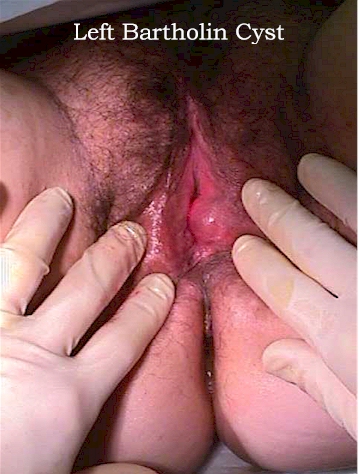|
OBGYN Skills Lab
|
|||||||||
|
Surgical Drainage of a Bartholin Duct Cyst Video Should the Bartholin gland become infected, it will form a Bartholin abscess. In this case, the labia majora becomes excruciatingly painful, red and swollen. Some of these will drain spontaneously and this process may be hastened by warm moist dressings or sitz baths. Others will require drainage. It is a relatively simple procedure to drain Bartholin cysts or abscesses. Incision and Drainage of the abscess gives immediate relief. Watch this video for a demonstration of this procedure on a Bartholin cyst:
Simple incision and drainage of the abscess will provide immediate relief and more likely than not, permanent cure. In a significant minority of patients treated with simple I&D, the abscess or cyst will re-occur. This happens because after healing, the surgical opening into the cyst or abscess cavity seals over, resulting in isolation of the Bartholin gland beneath the skin. For this reason, more aggressive surgical treatment is sometimes used. Packing the abscess cavity with gauze and leaving a wick external to the cavity is not an effective technique with Bartholin cysts and abscesses. Early in my surgical career, I used this method a number of times and never had the packing remain in the cavity for more than a few hours. One commonly used, good technique to keep the drainage tract open is the insertion of a "Word Catheter." A Word catheter is a soft rubber tube with an inflatable tip. After drainage is established, insert the tip of the Word catheter into the cavity and inflate the balloon tip with a few cc of any physiologic liquid such as sterile saline or lidocaine. The inflated balloon tip will keep the catheter from becoming dislodged and the stalk of the catheter will help keep the drainage tract open long enough for the cut skin edges to re-epithelialize to the inside of the cyst. Essentially, this results in a new duct connecting the Bartholin gland directly to the skin surface. The stalk of the catheter is bent back and inserted into the vagina, so it can be left in place for many days. Ideally, it should be left for a few weeks, but it is irritating enough to the patient that it may need to be removed after several days. Even this short period of time is enough for it to be effective. Even with the Word catheter, there may still be recurrences of the cyst or abscess, but they are less frequent than with the simple I&D procedures. Another way to accomplish the creation of a new drainage tract is to "marsupialize" the cyst or abscess. After opening the cyst, suture the squamous epithelial skin edge to the cuboidal epithelial cyst wall. This allows the cut skin cell fibroblasts the opportunity to spread down into the cyst, with creation of a new opening, allowing secretions to escape.
|
||||||||
|
This information is provided by The Brookside Associates, a private organization, not affiliated with any governmental agency. The opinions presented here are those of the author and do not necessarily represent the opinions of the Brookside Associates. For educational simplicity, only one method is usually shown, but many alternative methods may give satisfactory or superior results. This information is provided solely for educational purposes. The practice of medicine and surgery is regulated by statute and restricted to licensed professionals and those in training under supervision. Performing these procedures outside of that setting is a bad idea, is not recommended, and may be illegal. The presence of any advertising on these pages does not constitute an endorsement of that product or service by the Brookside Associates. C. 2010 All Rights Reserved |
|||||||||
 This is the Archived Desktop Edition.
This is the Archived Desktop Edition. 